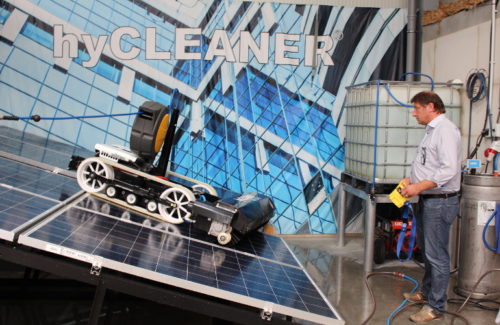
 Industry News
Industry News
Stade de Suisse in Bern, Switzerland, is one of the most unique soccer stadiums in the world. It is the second largest all-seater soccer stadium in Switzerland, with a capacity of 32,000. The stadium is the home to one of the country’s most successful soccer teams and has hosted concerts for musical powerhouses such as Bruce Springsteen, Pink and Bon Jovi.

The power from the stadium’s solar array is one of its most fascinating features. The stadium is 100% solar powered by 7,930 modules, providing an overall output of around 1.3 MW. The plant produces an annual energy yield of 1,134,045 kWh and saves on the emission of nearly 700 tons of carbon dioxide every year.
To keep the stadium’s vast solar capacity performing at optimum levels, stadium executives have adapted an emerging technology to clean the modules. The system, designed by TG hyLIFT GmbH of Germany, includes a battery-powered, remote-controlled machine that enables operators to clean up to five-times faster than manual labor. This “buggy” is safer than manual cleaning of solar panels and improves the efficiency of the solar power system.
“The concept of solar plant cleaning is still largely unknown in the industry,’’ said Andreas Grochowiak, TG hyLIFT’s managing director. “We have to start here and convince solar operators and service providers in the facility management industry of our product.”
The company’s hyCLEANER black SOLAR cleaner is available In the United States from Eurofits LLC in Brooklyn, New York, and is helping to maximize the performance of solar systems.
Buggy brushes solar panels
The hyCLEANER black SOLAR looks like a little car and moves on four wheels with two toothed-belts. The belts are covered with special straps that grip the wet surface and can move at angles up to 35°. The buggy can cross over 35-cm (13.7-in.) gaps of panels.
Users need a water connection to start the machine. A reel manages the hose connection, and surfaces are cleaned with water and a special cleaning brush. The brush is 90-cm wide with a diameter of 30 cm. Other sizes are also available. The brush rotates at 400 revolutions per minute.
The unit is powered by lithium-ion batteries that can last for more than three hours. The device also cleans up to five-times faster than manual labor.
“It was our aim to enable gentle, fast and efficient cleaning of solar panels when using the hyCLEANER system,’’ Grochowiak said. “Work safety was a big issue, which we were able to resolve by the development of this system.”
Several products from igus, a Germany-based manufacturer of motion plastics, play key parts in the design of the hyCLEANER. The components from igus, which runs its North American operations out of Providence, Rhode Island, are lubrication- and maintenance-free. They also resist debris and corrosion, which are particularly important features in an exterior application.
Plastic bushings and bearings
The wheels on the assembly are made of a polyoxymethylene material and guided by a stainless steel shaft. Bushings made with igus’ iglide P material help prevent wear between the two materials. The bushings are designed for outdoor use and absorb moisture in low quantities.
“In order to prevent wear between the two materials and thus increase the service life of the cleaning machine, we decided to use the iglide P plain bearings from igus,’’ Grochowiak said.
The shaft end of the brush includes igubal EFSM fixed flange bearings, which help compensate for misalignment. The spherical ball of the fixed flange bearing is made with iglide W300, which is characterized by high wear resistance and service life.
“We wanted to develop and create machine technology that does not require any greased rotating components such as wheels, rollers and brushes,’’ Grochowiak said. “The use of greased rotating components in cleaning machines is something that would not have been accepted by the customers and users of our machines. Possible leaks could negatively affect the cleaning results.”
Improved safety and efficiency
Dirt on solar panels can decrease efficiency by as much up to 30%. Dirt can also damage coatings and seals, which can lead to the total failure of the system. The weakest module in a solar energy system impacts the entire performance of an array.
Dirt can accumulate in any setting. Solar panels are frequently used, for instance, in agricultural areas. But they are subject to significant dirt accumulation through environmental factors. Ammonia vapors in livestock farming can also reduce the efficiency of surfaces generating solar power. Dust and pollen do not wash off in rain, and even bird droppings on individual cells can reduce the power of a solar energy system.
Most operators at solar power facilities use manual labor to clean panels. But some areas can be hard to access, and solar power materials are sensitive. “Manual work by personnel is a common solution, but it can be dangerous and physically demanding,’’ Grochowiak said.
The hyCLEANER black SOLAR regularly cleans 12,000 sq. m—nearly 7.5 miles—of the solar energy system at Stade de Suisse. The system has also been used at several other notable solar projects, such as the Marineda City shopping center in Spain and the Amheim Central train station in the Netherlands. TG hyLIFT is an outdoor cleaning specialist with over 30 years of experience in height access technology. Its products clean a wide variety of roofs and facades.
“We use our position as the market leader to develop products further,” Grochowiak said. “Our customers allow us to be in this position, thanks to the trust they place in us and our products.”